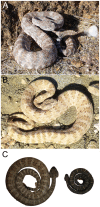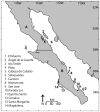Body size evolution in insular speckled rattlesnakes (Viperidae: Crotalus mitchellii)
- PMID: 20209105
- PMCID: PMC2832004
- DOI: 10.1371/journal.pone.0009524
Body size evolution in insular speckled rattlesnakes (Viperidae: Crotalus mitchellii)
Abstract
Background: Speckled rattlesnakes (Crotalus mitchellii) inhabit multiple islands off the coast of Baja California, Mexico. Two of the 14 known insular populations have been recognized as subspecies based primarily on body size divergence from putative mainland ancestral populations; however, a survey of body size variation from other islands occupied by these snakes has not been previously reported. We examined body size variation between island and mainland speckled rattlesnakes, and the relationship between body size and various island physical variables among 12 island populations. We also examined relative head size among giant, dwarfed, and mainland speckled rattlesnakes to determine whether allometric differences conformed to predictions of gape size (and indirectly body size) evolving in response to shifts in prey size.
Methodology/principal findings: Insular speckled rattlesnakes show considerable variation in body size when compared to mainland source subspecies. In addition to previously known instances of gigantism on Angel de la Guarda and dwarfism on El Muerto, various degrees of body size decrease have occurred frequently in this taxon, with dwarfed rattlesnakes occurring mostly on small, recently isolated, land-bridge islands. Regression models using the Akaike information criterion (AIC) showed that mean SVL of insular populations was most strongly correlated with island area, suggesting the influence of selection for different body size optima for islands of different size. Allometric differences in head size of giant and dwarf rattlesnakes revealed patterns consistent with shifts to larger and smaller prey, respectively.
Conclusions/significance: Our data provide the first example of a clear relationship between body size and island area in a squamate reptile species; among vertebrates this pattern has been previously documented in few insular mammals. This finding suggests that selection for body size is influenced by changes in community dynamics that are related to graded differences in area over what are otherwise similar bioclimatic conditions. We hypothesize that in this system shifts to larger prey, episodic saturation and depression of primary prey density, and predator release may have led to insular gigantism, and that shifts to smaller prey and increased reproductive efficiency in the presence of intense intraspecific competition may have led to insular dwarfism.
Conflict of interest statement
Figures



Similar articles
-
Rapid and repeated origin of insular gigantism and dwarfism in Australian tiger snakes.Evolution. 2005 Jan;59(1):226-33. Evolution. 2005. PMID: 15792242
-
Reduced predator species richness drives the body gigantism of a frog species on the Zhoushan Archipelago in China.J Anim Ecol. 2011 Jan;80(1):171-82. doi: 10.1111/j.1365-2656.2010.01746.x. Epub 2010 Sep 14. J Anim Ecol. 2011. PMID: 20840555
-
Evolution of rattlesnakes (Viperidae; Crotalus) in the warm deserts of western North America shaped by Neogene vicariance and Quaternary climate change.Mol Ecol. 2006 Oct;15(11):3353-74. doi: 10.1111/j.1365-294X.2006.03007.x. Mol Ecol. 2006. PMID: 16968275
-
Body size structure of Pleistocene mammalian communities: what support is there for the "island rule"?Integr Zool. 2009 Dec;4(4):341-56. doi: 10.1111/j.1749-4877.2009.00175.x. Integr Zool. 2009. PMID: 21392307 Review.
-
Additional observations and notes on the natural history of the prairie rattlesnake (Crotalus viridis) in Colorado.Top Companion Anim Med. 2013 Nov;28(4):167-76. doi: 10.1053/j.tcam.2013.09.008. Top Companion Anim Med. 2013. PMID: 24331557 Review.
Cited by
-
The tale of the rattle: Using rattle size to understand growth and sexual dimorphism in an insular population of rattlesnakes (Crotalus oreganus caliginis).Ecol Evol. 2024 Jul 10;14(7):e70005. doi: 10.1002/ece3.70005. eCollection 2024 Jul. Ecol Evol. 2024. PMID: 38988347 Free PMC article.
-
Phenotypic evolution of dispersal-enhancing traits in insular voles.Proc Biol Sci. 2011 Jan 22;278(1703):225-32. doi: 10.1098/rspb.2010.1325. Epub 2010 Aug 4. Proc Biol Sci. 2011. PMID: 20685710 Free PMC article.
-
Minimum area thresholds for rattlesnakes and colubrid snakes on islands in the Gulf of California, Mexico.Ecol Evol. 2017 Dec 12;8(2):928-934. doi: 10.1002/ece3.3658. eCollection 2018 Jan. Ecol Evol. 2017. PMID: 29375766 Free PMC article.
-
The biology and toxinology of blunt-nosed vipers.NPJ Biodivers. 2025 Jun 3;4(1):21. doi: 10.1038/s44185-025-00090-w. NPJ Biodivers. 2025. PMID: 40461826 Free PMC article. Review.
-
Measuring the evolution of body size in mammals.Proc Natl Acad Sci U S A. 2012 Mar 13;109(11):4027-8. doi: 10.1073/pnas.1201030109. Epub 2012 Feb 21. Proc Natl Acad Sci U S A. 2012. PMID: 22355132 Free PMC article. No abstract available.
References
-
- Darwin C. London: J. Murray; 1845. The voyage of the Beagle.
-
- Wallace AR. London: Macmillan; 1880. Island life.
-
- MacArthur RH, Wilson EO. xi. Princeton, N.J.: Princeton University Press; 1967. The theory of island biogeography.203
-
- Lomolino MV. Body size of mammals on islands: the island rule reexamined. Am Nat. 1985;125:310–316.
-
- Grant PR. xiv. Oxford: Oxford University Press; 1998. Evolution on islands.334
Publication types
MeSH terms
LinkOut - more resources
Full Text Sources

